Peter MALONE
Saturday, 18 September 2021 19:22
Getting Straight
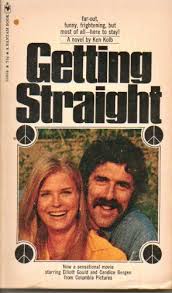
GETTING STRAIGHT
US, 1969, 123 minutes, Colour.
Elliot Gould, Candice Bergen, Robert F. Lyons.
Directed by Richard Rush.
Getting Straight is one of those campus revolution films of 1969-70 that were severely rubbished by the critics as being phoney and commercial exploitation of serious social situations, (The Strawberry Statement, R.P.M.). Getting Straight is certainly well made, even if the techniques are slick. The students here are not the freshers of The Strawberry Statement, but older students. In fact, the hero has been at University, served in Vietnam and returned to further his studies for a teaching career. The level of protest, therefore, is older and potentially more telling. However, Elliot Gould is not entirely sympathetic as the hero and the proceedings turn to farce during his oral examination of Scott Fitzgerald. The language and behaviour of the students are particularly frank in this film and the scenes of campus violence particularly strong, showing the provocation on both sides. The film was quite popular when released. It is a film for older audiences both in tone and in sympathy with the (comparatively) older hero and his interests.
1. This film was severely attacked by critics for being shallow, slick and exploiting and commercialising campus unrest. Do you agree with these charges?
2. Would the impact of the film have been different had it had for its hero a 20 year old (like The Strawberry Statement) instead of a man who had been to University, to Vietnam and had grown a bit older and wiser before his return to campus?
3. What impression of the American university life did the opening scenes of crowds, hustle and mechanisation make?
4. Was Harry a revolutionary? What did he want to make of his life?
5. Was Harry a likeable hero - a mixture of Groucho Marx (and Elliot Gould in other films) and a student, promiscuous, selfish, abrupt, cheating, trying to be 'honest'? He wants to get teacher credentials.
6. Was Jan a likeable heroine - intelligent, 'ruined', searching, intense, conventional, loving, 'bitchy', not wanting to be a servant, wanting a normal life?
7. How typical was Nick - 'high’, odd, clever, clown, his act to avoid the draft. his haircut and change to the marines ' who want people who are mad to kill, not just mad'?
8. How typical was Bill - doctor, patronising, as amoral as the next man, but conventional?
9. What picture of university life did the film give - study. crowded, earthy, amoral, crude; demonstrations and rioting; intensity; black and white Americans? Yet Harry says it is isolated - he was at Selma; the comments on Vietnam -'The graves come to the surface during the floods'.
10. Did the film take sides during the riot scenes or did it film them impartially (student stirring and provocation as well as police brutality)? There are senseless bashing on both sides. What sense did the violence make?
11. How responsible was Harry in his interview with the Dean? How responsible was the Dean?
12. How much compromise has to be? - the liberals don't want the universities run by kids; the administrations are unreal and twenty years too late in their offering of responsibility - like inviting some hundreds of peasants to a ball to stave off the French Revolution.
13. How much freedom to make mistakes should be allowed? Why does the suppression of choice make revolutionaries of protestors?
14. Does Harry find himself? He ridicules Jan for her conventionality and then wants to make himself and be a teacher.
15. Was the caricature on University academics and the exam too heavy-handed? What was the purpose of emphasising Scott Fitzgerald and homosexuality by the fanatic professor?
16. Harry wants to teach authentically. How right is he in saying that university degrees are 'publicly-endorsed crap'?
17. What does the end of the film mean? Is the real world so completely stupid that oneself and love are the only authenticity?
18, Why was this film made? What effect would it have on 'campus radicals'? on parents and teachers?
Published in Movie Reviews
Published in
Movie Reviews
Tagged under
Saturday, 18 September 2021 19:22
Get Crazy
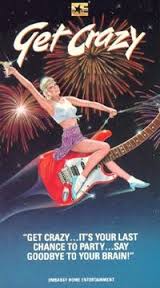
GET CRAZY
US, 1983, 88 minutes, Colour.
Malcolm Mc Dowell, Daniel Stern, Allen Goorwitz, Ed Begley Jr, Lou Reed, Mary Woronov, Dick Miller.
Directed by Alan Arkush.
Get Crazy would have to be an outstanding oddball film. It is difficult to detect for whom the film was made. It purports to show New Year's Eve in New York '82-'83. With the focus on a theatre (like American Hot Wax), Allen Goorwitz is preparing his 15th. anniversary New Year's Eve Show. Daniel Stern is his stage manager. Many things go wrong in the theatre, the groups put on tantrums, there is an evil group with subtitle 'The Baddies' to indicate them, led by Ed Begley, who come to a stink-bomb end, a heroine who used to work for Goorwitz and who falls in love with the stage manager, the stage manager's
star struck younger sister etc. etc.
The whole thing is presented frantically with so many touches of adolescent humour. Dialogue and subtitles are corny. Once the music starts it is of the raucous rock and punk style. The most surprising thing is the lead billing given to Malcolm McDowall? who portrays a Liverpool rock and roll star 20 years on. He has several provocative numbers - imitating various rock stars. He also has some execrable dialogue, especially in a toilet at the end.
The film has several technicians and actors and actresses from Roger Corman's New World Company. It was directed by Alan Arkush who co-directed (with Joe Dante) the satiric Hollywood Boulevard. As a curiosity item for the people involved, Get Crazy is an almost must see. However, it is fairly excruciating to sit through.
Published in Movie Reviews
Published in
Movie Reviews
Tagged under
Saturday, 18 September 2021 19:22
Get Carter
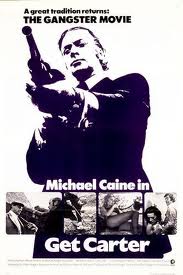
GET CARTER
UK, 1971, 112 minutes, Colour.
Michael Caine, John Osborne, Ian Hendry, Britt Ekland.
Directed by Mike Hodges.
The main reason for seeing this film is that you enjoy gangster movies. This it is, and quite a violent one whose impact is stronger than usual, probably because it is set in Newcastle- on- Tyne, in slums, on ugly bridges and dreary beaches - no Chicago mystique, no glamour, just greed, exploitation and perversion. There are no pleasant characters, not even Carter himself, though he shows some basic feelings which are then used to feed his revenge. Michael Caine is as usual as Carter. Playwright John Osborne portrays one of the villains. A grim story about the type of gangster you read about in most big cities
1. What audience is a film like this made for? Why?
2. The film presents an ugly world, an ugly underworld, Is such a prolonged immersion in such a world a healthy experience? or has the film positive merit? Redeeming features? Is there a value for the ordinary movie-goer to see something of this 'other' world? Why?
3. Is the film successful within its genre? What are the reasons for its success or failures?
4. How much of the film's success and impact depends on Michael Caine's performance as Carter? Why? What kind of person was Carter? Why? Good qualities? Bad? Could an audience identify with him easily? Was he on the side of good -against evil?
5. This kind of underworld is usually associated with America. What is the impact of seeing the British equivalent? Does it make it seem uglier or not?
6. What moral standards does the film work in - are there any standards? For Carter - what is the basis of his sense of right and wrong? Does it presuppose moral standards in the audience to judge the film by?
7. How did each of the supporting characters come across - as personalities or cliches?
8. What kind of people were they? How was this tested by their encounter with Carter?
- Anna - sensuality. fidelity;
- Kinnear - boss.. power, sleazy, cruel;
- Eric Paice - criminal, procurer. conscience-less;
- Glenda - ambiguous attitudes. saving herself;
- Brumby - racketeer;
- Margater, Doreen, Swift - the blue movie.
Were any characters pleasant at all?
9. How gratuitous the violence? How necessary?
10. The impact of the British, Newcastle environment on the action and issues of the film?
11. Carter's death - its meaning. as a conclusion to this film, the irony of it?
12. What was Carter's mission, purpose in life? Does this film bear much resemblance to the realities of modern gangster life?
Published in Movie Reviews
Published in
Movie Reviews
Tagged under
Saturday, 18 September 2021 19:22
Gervaise
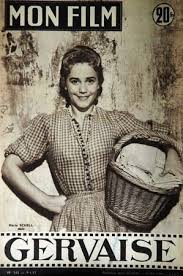
GERVAISE
France, 1956, 108 minutes, Black and White.
Maria Schell, Francois Perrier.
Directed by Rene Clement.
Gervaise is a film version of Emile Zola's novel of a character immersed in the squalid social conditions of late nineteenth century France. Here the atmosphere is excellently re-created and makes a great impression on the audience and makes the film worth seeing.
Maria Schell gives a fine performance as the partly likeable, partly repellent heroine who suffers in the harsh conditions in which her life has to be lived. As she is victimised by her milieu and by her enemies, we grow in pity for her and the film ends on a sadly depressing note. Rene Clement has directed such fine films as Forbidden Games, Full Sun and Rider on the Rain.
A moving version of a novel by a famous author.
1. Comment on the effectiveness of the period atmosphere of the film - e.g., the laundry, the shops, the dinner and the goose. Did the film immerse its plot and its issues in this authentic period setting?
2. What kind of a woman was Gervaise - were we supposed to like her, to pity her? How did she change during the film?
3. How did she react to being abandoned by her de facto husband, left sad and abandoned with her children? What rights did she have in the France of her time?
4. Why did the film make so much of her fight with Virginie in the laundry?
5. How did her husband and her married life change Gervaise - ambition, the shop, looking after her husband, a sense of achievement?
6. How did Virginie take over Gervaise's life?
7. Why did Gervaise fear her former de facto husband and take risks?
8. Comment on Virginie's revenge on Gervaise - ruining her by love and deception in her friendship.
9. What was the impact of the ending, the child, the drink and her mother's glazed eyes?
10. What social comment did the film offer on poverty, squalor, ambition, the love and hatred of ordinary working people?
11. Could the film be justly described as 'pessimistic realism'?
Published in Movie Reviews
Published in
Movie Reviews
Tagged under
Saturday, 18 September 2021 19:22
Gentlemen's Agreement

GENTLEMEN'S AGREEMENT
US, 1947, 118 minutes, Black and White.
Gregory Peck, Dorothy Mc Guire, John Garfield, Celeste Holm, Ann Revere, Dean Stockwell.
Directed by Elia Kazan.
Gentlemen's Agreement made a strong impression when released soon after the war. It had a double-edge advantage coming so soon after the war. On the one hand, Americans were revolted at Hitler's extermination of the Jews, on the other there were strong feelings of anti-Semitism amongst ordinary Americans.
Anti-Semitism? is frequently harder to pin down than the more obvious racism of black versus white. However, it has had an extraordinarily long tradition and has not been eradicated. This film shows it working in various sections of New York public life, and how a writer passing for a Jew finds prejudice and hostility where he did not expect it. The film is well made, although some of its techniques for getting its point across seem obvious. It was directed by Elia Kazan who has made some strong social dramas including A Streetcar Named Desire and On the Waterfront. More recently he made an autobiographical film, America, America (1963) and the interesting drama of modern business life and worries in the U.S., The Arrangement, based on his own novel.
Gentlemen's Agreement is a social film worth seeing and discussing.
1. What is your knowledge of anti-Semitism - in the past, at the time of the film's release? Today?
2. Are we really capable of feeling like someone else from the inside? Does this film help us to see this, and feel the anti-Semitic hostility?
3. Why is there anti-Semitism? Race? Money management? Beliefs? Does the film make this clear?
4. How does the film show this prejudice is manifested? Are people shown being hostile without their noticing?
5. Did you admire Phil Green? Did he do a good thing in passing for Jewish?
6. It could be said that his experience was not typical, as he tested all anti-Semitic feeling within a short space of time. Do you agree?
7. What is the role of Kathy? Ingrained prejudice of which she is unaware - (the best way she can console Tommy after he has been bashed is by reassuring him that he is not a Jew, that it was a lie). She sees prejudice, knows her family shares this, but does nothing about it.
8. What is the role of Phil's mother? Noble momism, the sturdy, tough, encouraging Mother America?
9. The film exhibits an extraordinarily optimistic vision of a great free America. Would this be included in the film now? What has happened to U.S. vision since 1947?
10. Discuss Dave as a 'typical' Jew.
11. Do conventions and the romantic ending spoil the impact of the film?
Published in Movie Reviews
Published in
Movie Reviews
Tagged under
Saturday, 18 September 2021 19:22
Gentlemen Prefer Blondes

GENTLEMEN PREFER BLONDES
US, 1953, 85 Minutes, Colour.
Jane Russell, Marilyn Monroe, Charles Coburn, Elliott Reid, Tommy Noonan.
Directed by Howard Hawks.
Gentlemen Prefer Blondes is a very funny and entertaining musical. Based on the story by Anita Loos, it tells the story of two innocent naive gold-diggers. They are played by the sex-symbols of the 50s, Jane Russell and Marilyn Monroe. Jane Russell by this stage had already achieved a reputation for her style. Marilyn Monroe was just about to emerge in stardom. It was the period of Niagara and How to Marry a Millionaire. Some of their songs are most entertaining, especially Diamonds are a Girl's Best Friend'. The film was directed with great verve by veteran director Howard Hawks, a film-maker of the 30s and the 40s with a very wide range, from only Angels Have Wings through some war films and some bright comedies like Bringing Up Baby and Ball of Fire, he had made Red River and was soon to make Land of the Pharaohs. He continued with Westerns and comedies into the 60s and 70s. The film is entertaining and looks as if the whole cast enjoyed making it. There is some wry light comedy on American manners.
1. Was this an enjoyable musical comedy? Is it now dated? Why?
2. The importance of Marilyn Monroe and Jane Russell for this film? In their time? The impact now? Especially the way the camera focuses on them and presents them?
3. The film as: Americana; insights into American attitudes, American poses, American beliefs? - as comedy: is it funny? When? Why? - as satire: on human nature, on gold-diggers, foolish old men, rich young men, on American behaviour and attitudes, on the French, attitudes to women and sex? - as a film about women? Are they presented as persons? Are they sympathetic? Their ambitions for marriage, wealth, love? What aspects of women do Loralie and Dorothy represent? - as a comedy about men: the man in the film are inept. Why? How? Malone? Gus? His father? Sir Frances Beakman? (the contrast with Lady Beakman?) - as a film about love; how did Loralie and Dorothy love? Malone and Gus? How did true love triumph at the end? Did this ring true? -as a film about money: the emphasis and lines of dialogue on money, money-making, on diamonds, on greed? - as a film about fools: all the characters being foolish? How?
4. What did the songs contribute to the film? As entertainment? Satire? The girls from Little Rock: The goodbye song on the Ship? Dorothy's songs with the athletes? And Diamonds are a Girl's Best Friend, as sung by Loralie, as sung in the court by Dorothy?
5. The film had a happy ending recapitulating the Little Rock song from the beginning. How did this sum up the film? Was this a good film? Worth reviving?
Published in Movie Reviews
Published in
Movie Reviews
Tagged under
Saturday, 18 September 2021 19:22
Gentle Gunman, The

THE GENTLE GUNMAN
UK, 1952, British, 84 minutes, Black and White.
John Mills, Dirk Bogarde, Elizabeth Sellars, Robert Beatty, Joseph Tomelty, Jack Mac Gowran, Barbara Mullen.
Directed by Basil Dearden.
The Gentle Gunman is set in Ireland in 1941, but it is as topical as 1916 or 1977. The film, though brief, is a complex look at the conflicting points of view on Ireland, her occupation by the British and her freedom. The intense national feeling is conveyed, especially in the terrorism sequences. The opening terrorist scene takes place in the London tube - which brings the Irish question vividly to a non-Irish audience. In contrast, the daily lives of the people are represented in the Irish mother who lost her husband who thought he was free, until he was told he wasn't, and then loses her son. The hardness and unyielding temper of the Irish is not overlooked. But the central issue concerns two brothers; the elder of them (John Mills) has learnt that horizons widen outside Ireland and that violence does not achieve all that it hopes to. His younger brother (Dirk Bogarde) is torn between what he has been brought up on, the taunts of traitor and coward, and the admiration he has always had for his brother.
The film was made by Sir Michael Balcon's Ealing Studios when they were at their peak and is finely acted and photographed - especially the actor's expressive profiles in close-up and the bleak Irish countryside. John Mills reminds us what a versatile actor he really is. The film was produced by Michael Relph and directed by Basil Dearden, a team who worked together for years, later examples of their work being Masquerade, Women of Straw, The Assassination Bureau and The Man Who Haunted Himself. The Gentle Gunman is worth seeing.
1. What was the Irish point of view on England, its occupation of Ireland, Northern Ireland, resistance, the I.R.A.?
2. What was the English point of view? (Note: the film is framed in discussions between the Irish doctor and his English friend.) How serious and how hopeless was the situation from each point of view?
3. What did the film say about terrorism? Its effects on children (is this a fair question or does it appeal to our sentiments for children's lives?); its limitations in effective protest; the responsibilities of terrorists?
4. The Irish considered themselves at war with England, even though they were not in uniform. Does that alter the point of view in judging terrorism and reprisals?
5. Molly says her husband was happy until Shinto told him he wasn't, free until he was told he was not. While he died a true Irishman, she wishes he could have lived as a true Irishman. How did Molly's role as a mother, who thought of people before causes, affect the audience's attitude to the situation? What about Maureen and her hardness? what about Johnny, his youth, loyalty, death?
6. Why did Terry change his mind? Was he a traitor? Was he a coward?
7. The audience was meant to keep Matt central and share his enthusiasm as well as his confusion. Did he have a mind of his own or was he too much influenced by Shinto and Terry? what decision had he made at the end as he walked off with Terry?
8. What did the film show about the hardness of the Irish character -the sense of injustice; its sense of cruel justice and vengeance; its religion and its willingness for martyrs?
9. The film was set in 1941, made in 1951. Were the issues any different from 1916, 1921, 1970-71?
Published in Movie Reviews
Published in
Movie Reviews
Tagged under
Saturday, 18 September 2021 19:22
Genevieve

GENEVIEVE
UK, 1953, 86 Minutes, Colour.
John Gregson, Dinah Sheridan, Kenneth More, Kay Kendall, Geoffrey Keen, Joyce Grenfell.
Directed by Henry Cornelius.
Genevieve is a classic British comedy and was extremely popular in the early 50s. Written by William Rose who was later to go to America and write such films as Guess Who's Coming to Dinner, the film was directed by Henry Cornelius who had only a short film career. The next year he was to make I Am a Camera (which became the musical, Cabaret). An entertaining cast, especially with comedians Kenneth More and Kay Kendall, give verve to this story of veteran cars and a
race from London to Brighton. There is a very enjoyable comic flavour about dialogue, situations, characters. Expert British comedy.
1. Why is this a classic British comedy? Why so enjoyable? Its best qualities?
2. How typical a film of the 50s? How British? Comment on its low-key style? The importance of incidents and satire?
3. The use of colour, sets in Brighton, the vintage cars, the value of the musical themes?
4. Why are cars always so interesting and appealing? The value of veteran cars and the way they were presented? The theme of cars and the mechanical attraction for men, men's devotion, pride, sentiment, the implications of the parade to Brighton, the race back?
5. The human values in the film? Especially in terms of cars, obsession, serving cars, acting like children? How did this contrast with the ordinary behaviour, eg. of the wives and girlfriends? What comment was made on human behaviour regarding cars?
6. Alan and his wife: their ordinariness, fighting, reconciliation, the comedy in this, their feelings, getting there, the hotel, the dinner, the jealousies, the reactions to the bets, the uglier aspects of the race? The fact that they were the 'goodies'?
7. Ambrose and Rosalind: satire on their social types, their smartness, Rosalind's drinking and the trumpet playing, the race, the bad aspects of the race, the fact that they seemed the baddies?
8. The irony of Genevieve winning by herself? Comment on the devices, tricks, humour of the race?
9. The main traits of humour: the laughs, the parody, the lines, Joyce Grenfell, the police, Reginald Beckwith etc.?
10. How ironic was the ending?
Published in Movie Reviews
Published in
Movie Reviews
Tagged under
Saturday, 18 September 2021 19:22
General, The

THE GENERAL
US, 1926, 80 minutes, Black and white.
Buster Keaton, Marion Mack, Glen Cavander.
Directed by Buster Keaton and Clyde Bruckman.
The General is a classic comedy written and co-directed by Buster Keaton, starring himself. It comes from 1926, the end of the silent era.
The film capitalises on the strengths of silent film-making. Keaton himself (never smiling) provides a great deal of personal comedy as well as slapstick and acrobatics. There are excellent stunts and effects with two main sequences - Keaton pursuing a train, and then the return trip with his being pursued.
While the film has fixed camera, there is a great deal of movement. There are also interesting interiors in the southern town as well as the train and exteriors with vast numbers of soldiers fighting in the civil war.
The film Is considered a comedy classic - with both Keaton himself, his persona, and the special effects with the train. One can see how later film-makers were influenced by various sequences, for example such train comedies as The Silver Streak or even Danny Kaye under the table with the spies in Knock on Wood, echoing Keaton's scene under the table as the Union generals make their plans.
The film is based on a true incident which was dramatised seriously by Disney in the '50s as The Great Locomotive Chase.
1. The work of Buster Keaton, his screen persona, serious hero, acrobatic style? His personal comedy?
2. The film industry in the 1920s, techniques, black and white photography, fixed camera. action, crowd sequences, the countryside, sets?
3. The background of the civil war, sympathy for the South, antipathy for the North?
4. Buster Keaton's Johnny Gray: simple man, driving the General, his engineering skills, the break-out of the war, his love for the girl, his courting her, the enlistment sequence and his many attempts to enlist, his being spurned by the heroine and her father, the train being stolen, the girl on board, his pursuit?
5. The central focus on the train sequences: the use of outdoor locations, the focus on the engine, the devices for delay with the taking up of the rails, no rails, the sleepers on the track, the burning carriage, etc? His pursuit of the train? Farcical touches, for example with the water spraying everyone? The cannon and its facing the engine, firing at the bend of the rails? The bridge sequence?
6. Johnny hearing the plans under the table, the comedy under the table, the girl in the other room, the rescue, the escape, the night in the countryside?
7. The reverse trip, the slow train, the devices for warding off the Union pursuers. Johnny on and off the train?
8. The build-up to the fight, the generals and the officers, the sniper and the dead soldiers around the cannon, his capture of the Union leader?
9. His becoming a lieutenant, his heroics - and the final kissing of the heroine with the continued salute?
10. Keaton and his human touch, the blend of slapstick and farce with more serious tones?
11. A piece of Americana, memories of the civil war? Comic viewpoint?
Published in Movie Reviews
Published in
Movie Reviews
Tagged under
Saturday, 18 September 2021 19:22
Gnome-Mobile, The
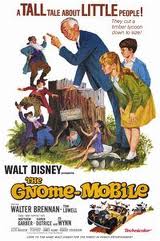
THE GNOME-MOBILE
US, 1967, 90 minutes, Colour.
Walter Brennan, Matthew Garber, Karen Dotrice, Richard Deacon, Sean Mc Clory, Ed Wynn, Jerome Cowan, Charles Lane.
Directed by Robert Stevenson.
The Gnome- Mobile is one of Walt Disney's more delightful fantasies. It was directed by Robert Stevenson, who directed a number of Disney features, most importantly Mary Poppins. In fact, the two young stars Matthew Garber and Karen Dotrice were in Mary Poppins.
The film has a contemporary setting but shows us gnomes living in the forests north of San Francisco. Walter Brennan enjoys himself as a lumber tycoon and as the most cantankerous of the old gnomes. There is a lot of fantasy blending of contemporary American business with the world of the gnomes, excellent process and special effect photography.
The film is based on a novel by the celebrated American author Upton Sinclair.
1. An appealing fantasy? For family audiences? For children?
2. Disney production values: colour photography, Californian locations, the city, the forest? The importance of the special effects work for creating the gnomes? The animation for the talking animals? The interplay of normal sized characters with the gnomes? With Walter Brennan playing two characters? The special effects for the chase sequences and the collapse of the asylum car? The musical score and the jaunty theme?
3. The focus on the children? Audiences identifying with Rodney and Elizabeth? Their seeing their grandfather? The arrival in the city? The decision to go for the picnic? The car-ride? Elizabeth meeting Jasper? The appeal for help? Elizabeth enlisting her grandfather's help? Rodney and his help? The taking of the gnomes north? The finding of another place for them? The staying at the motel? Their being kidnapped? The children concerned? The taking of their grandfather to the sanatorium? The children helping their grandfather to escape? The mad chase? The happy ending and the satisfaction the children got from helping the gnomes?
4. Walter Brennan as D. J. Mulrooney - genial grandfather, his wealth, the car, the picnic, his talking about the forests? His decision to help Jasper, driving Jasper and Knobby to the untouched forest? The joy ride in the Rolls Royce - the Gnome-Mobile? The attack by Knobby on Mulrooney? Hiding the gnomes at the motel? The attack by Knobby? D. J. Mulrooney being taken to the sanatorium, his Vice President having him certified? The escape, the chase, D. J. searching for Jasper and Knobby when they were taken by the freak show? The rescuing of the gnomes? The meeting with Rufus? The beautiful gnomes and the competition for Jasper's hand? The final bequeathing of the fifty thousand acres of the forest for the gnomes? The happy ending with the ride? Walter
Brennan's differing styles as D. J. and Knobby?
5. Jasper and his searching for help, the encounter with the children, Knobby and Jasper being kidnapped by the proprietor of the freak show? Their being rescued? The mad chase? The Kingdom of the Gnomes? The race for the catching of the wife? Violet and her shyness, her marrying Jasper?
6. The presentation of the humans - much less sympathetic than the gnomes? The Vice President and his concern about D. J., having him committed to the sanatorium? The madcap chase and the fun at the expense of the humans? Horatio Quackston and his freak show, stealing the gnomes?
7. The delight of this kind of contemporary fairy tale? The delight in fantasy? The message about ecology, business? A pleasant table for younger audiences?
Published in Movie Reviews
Published in
Movie Reviews
Tagged under